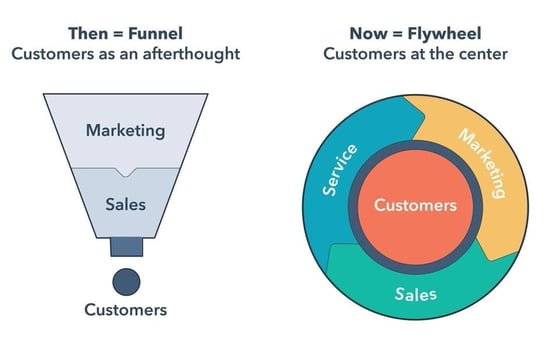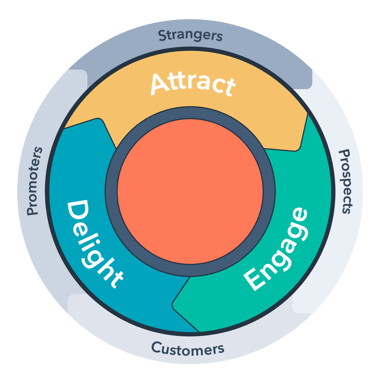The Marketing Funnel Reimagined: Embracing the Power of the Flywheel

In 2018, we witnessed a paradigm shift in marketing strategies with the introduction of the flywheel model. The marketing funnel, which had long been the cornerstone of marketing methodologies, was put into question due to its inherent focus on marketing and sales over serving customers. The flywheel came to light, emphasizing a customer-centric approach that prioritized service as much as attracting and converting leads.
As we endeavored to replace the funnel with the flywheel, we realized a transformative insight—the flywheel didn't replace the funnel, it complemented and redefined it.
Evolution of the Flywheel Model
Over time, the flywheel model has undergone numerous adaptations and improvements. In one iteration, it mapped "marketing, sales, and service" around the customer. In another, it was envisioned through the lens of the inbound methodology—"attract, engage, and delight". We've also seen instances where these interpretations were combined or depicted as nested flywheels.
This signifies the evolving and transformative nature of the flywheel model.
The Flywheel and Funnel: A Symbiotic Relationship
While the flywheel has proved itself as more than a marketing buzzword and a guiding principle for company growth, it's not a stand-alone solution. The funnel isn’t going away. They coexist and function in synergy, reinforcing each other.
The funnel serves as a crucial mechanism to measure how your business attracts new opportunities. In contrast, the flywheel reflects the customer experience journey within your company. These two concepts, working in tandem, shape a robust marketing strategy.
To understand how to seamlessly integrate the flywheel model into your business, let's dive deeper into the core facets of marketing, sales, and service.
Marketing
Attract
The attract portion of your marketing efforts consists of using tactics like social media, content, SEO, and ads to draw people to your site that can benefit from your solution.
The key to the inbound marketing attract stage is meeting your prospects where they are at. You need to understand who your buyer personas are, what kind of information they’re looking for, and where they go to find it.
Engage
Once you attract visitors to your website with marketing content, you need to engage with them, so they’ll convert into a lead and continue interacting with your company. To do so, use tactics like pop-up forms, email marketing, chatbots, and marketing automation.
Personalized and contextually-relevant communications will help you stand out with your prospects at this stage. Rather than flooding prospects with every piece of content your team creates, provide them with content and information that caters to their interests.
Delight
This stage is about exceeding expectations and providing maximum value to your leads. Use smart content, email marketing, conversational marketing, video and long-form content to delight your leads with as many relevant educational materials as possible.
Encourage long-lasting brand loyalty with content that provides so much value your leads want to share it with others.
Sales
Attract
The attract stage of the sales flywheel overlaps with the marketing flywheel. As a lead is being engaged and delighted by marketing content, sales will start to reach out in an effort to attract them into the sales process. After this lead demonstrates sufficient interest in your company's offering and provides information indicating they'd benefit from it, the process begins.
Alternatively, leads can be attracted into the sales flywheel through prospecting. In that case, a personal connection that a prospect has made with a sales rep on social media, in person or through other communications is what draws them into the sales process.
Engage
Once a prospect has begun a conversation with sales, the sales team will continue to engage with them through meetings, calls and emails.
As you continue to guide prospects towards buying your offering, follow the mantra “always be helping.” Let your prospects dictate both the channels and timeline of your communications, and address their needs over selling whenever possible.
Delight
In order to delight customers in the sales process, make it as easy as possible for prospects to buy from you. Empower them with the info they require and create a great buying experience.
Enablement materials like one-sheets and videos can help with this, as they make it easy for your champion to share your company’s value proposition with other stakeholders involved in the buying process.
Going above and beyond to create a delightful sales experience for your prospects can lead them to refer you new business — attracting new prospects into your sales flywheel.
Service
Attract
You attract customers to your service with your marketing and sales process. When doing so, try to make becoming your customer as frictionless as possible and ensure you’re demonstrating your product or service’s value.
An effective way to do that is through assessments, product demos, freemium offerings or bringing members of your service delivery team onto sales calls. Giving your prospects a taste of your product or service allows them to gain first-hand experience of how it will benefit them, making a stronger case for why they should become your customers.
Engage
You engage with customers within the service flywheel by delivering superb customer service.
Ensure you establish clear expectations for communications and how customers can receive value from your product or service. Then, work to exceed those expectations and support your customers in using your offering to meet their goals.
In addition to having systems for communication and support, you should also have self-service resources like knowledge bases to help your customers maximize the value they gain from your offering.
Delight
When it comes to the delight stage of the service flywheel, expectation setting is the major factor for success. If you don’t set realistic expectations from the start, you won’t be able to exceed them and go above and beyond for your customers.
When you help your customers succeed, they’re more likely to want to return the favor for you. Then you can get case studies, reviews, and referrals that help your company attract more customers.
However, while you should work to delight all your customers, keep in mind that not everyone will become an evangelist, and that’s OK. Don’t devote so many resources toward delighting an unpleasable client that you can’t give adequate attention to your other customers.
The Takeaway
Using the flywheel ideology can help you foster brand advocates for your company who can drive growth. The flywheel's objective is not solely to increase revenue, but to enhance customer loyalty.
The secret to significant growth lies in placing customers at the core of your strategies. To kick-start your journey towards a customer-first approach, explore our comprehensive guide.
This post was originally published June 5, 2018.
Guido Bartolacci
Guido is Head of Product and Growth Strategy for New Breed. He specializes in running in-depth demand generation programs internally while assisting account managers in running them for our clients.




.png?width=383&name=unnamed%20(52).png)


